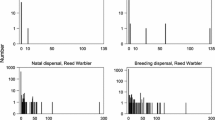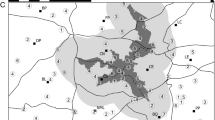Abstract
The crested porcupine Hystrix cristata is undergoing a marked range expansion in Italy, and it is reaching the northern regions, where it was historically absent. We studied its dispersal ability by marking 86 subadult individuals through coloured tapes on dorsal quills, in contrasting environmental context (i.e. coastal scrubland, deciduous woodland, suburbs, rural areas and farmlands), in Southern Tuscany. Recaptures occurred only for 14 (16.3%) of them, allowing us to evaluate dispersal patterns, which ranged from 180 to 4896 m. We showed that no sexual difference occurred in dispersal distances, as expected by the monogamous mating system of this rodent. The season did not affect dispersal patterns significantly, although most of these movements occurred at the peak of the main reproductive season. Dispersal distance increased with increasing home range and with increasing woodland cover (i.e. % of study site covered by woodland). Forest reexpansion in Italy may thus have promoted the range expansion by this species during the last 40 years.



Similar content being viewed by others
References
Andreassen HP, Stenseth NC, Ims RA (2002) Dispersal behavior and population dynamics of vertebrates. In: Bullock JM, Kenward RE, Hails RS (eds) Dispersal ecology. Blackwell Publishing, Malden, pp 237–256
Blanco JC, Cortés Y (2007) Dispersal patterns, social structure and mortality of wolves living in agricultural habitats in Spain. J Zool (Lond) 273:114–124
Bowman J, Jaeger JA, Fahrig L (2002) Dispersal distance of mammals is proportional to home range size. Ecology 83:2049–2055
Caughley G, Sinclair ARE (1994) Dispersal, dispersion and distribution. In: Caughley G, Sinclair ARE (eds) Wildlife ecology and management. Blackwell Publishing, Malden, pp 55–67
Cerri J, Mori E, Vivarelli M, Zaccaroni M (2017) Are wildlife value orientation useful tools to explain tolerance and illegal killing of wildlife by farmers in response to crop damage? Eur J Wildl Res 63:70
Chepko-Sade BD, Halpin ZT (1987) Mammalian dispersal patterns: the effects of social structure on population genetics. University of Chicago Press, Chicago
Ciucci P, Reggioni W, Maiorano L, Boitani L (2009) Long-distance dispersal of a rescued wolf from the northern Apennines to the western Alps. J Wildl Manag 73:1300–1306
Clutton-Brock TH, Albon SD, Guinness FE (1982) Competition between female relatives in a matrilocal mammal. Nature 300:178–180
Corsini MT, Lovari S, Sonnino S (1995) Temporal activity patterns of crested porcupines Hystrix cristata. J Zool (Lond) 236:43–54
Fattorini N, Pokheral CP (2012) Activity and habitat selection of the Indian crested porcupine. Ethol Ecol Evol 24:377–387
Fattorini N, Brunetti C, Baruzzi C, Macchi E, Pagliarella MC, Pallari N, Lovari S, Ferretti F (2018) Being “hangry”: food depletion and its cascading effects on social behaviour. Biol J Linn Soc. 125:640-656
Favre L, Balloux F, Goudet J, Perrin N (1997) Female-biased dispersal in the monogamous mammal Crocidura russula: evidence from field data and microsatellite patterns. Proc Royal Soc B 264:127–132
Felicioli A, Santini L (1994) Burrow entrance hole orientation and first emergence time in the crested porcupine Hystrix cristata L.: space-time dependence on sunset. Pol Ecol Stud 3(4):317–321
Gromov VS (2017) The evolution of sociality in rodents: a family affair. Russ J Theriol 16:11–38
Guazzini B (2009) Istrici in ambiente periurbano: uso dello spazio e selezione dello habitat. Tesi di Laurea in Scienze Biologiche, Università degli Studi di Siena, Siena
Hammer Ø, Harper DAT, Ryan PD (2001) PAST: paleontological statistics software package for education and data analysis. Palaeontol Electron 4:1–9
Lester SE, Ruttenberg BI, Gaines SD, Kinlan BP (2007) The relationship between dispersal ability and geographic range size. Ecol Lett 10:745–758
Long ES, Diefenbach DR, Rosenberry CS, Wallingford BD, Grund MD (2005) Forest cover influences dispersal distance of white-tailed deer. J Mammal 86:623–629
Lovari S, Sforzi A, Mori E (2013) Habitat richness affects home range size in a monogamous large rodent. Behav Proc 99:42–46
Lovari S, Corsini MT, Guazzini B, Romeo G, Mori E (2017) Suburban ecology of the crested porcupine in a heavily poached area: a global approach. Eur J Wildl Res 63:10
Lucherini M, Lovari S (1996) Habitat richness affects home range size in the red fox Vulpes vulpes. Behav Proc 36:103–106
Massolo A, Sforzi A, Lovari S (2003) Chemical immobilization of crested porcupine with Tiletamine HCl and Zolazepam HCl (Zoletil®) under field condition. J Wildl Diseases 39:727–731
Mohr E (1965) In: Ziemsen Verlag A, Wissenschaften W (eds) Altweltliche Stachelschweine. A. Ziemsen Verlag Publisher, Wittenburg Lutherstadt
Monetti L, Massolo A, Sforzi A, Lovari S (2005) Site selection and fidelity by crested porcupine for denning. Ethol Ecol Evol 17:149–159
Mori E, Lovari S (2014) Sexual size monomorphism in the crested porcupine (Hystrix cristata). Mammal Biol 79:157–160
Mori E, Menchetti M (2019) Living with roommates in a shared den: spatial and temporal segregation among semifossorial mammals. Behav Process 38:119–122
Mori E, Sforzi A, Di Febbraro M (2013) From the Apennines to the Alps: recent range expansion of the crested porcupine Hystrix cristata L., 1758 (Mammalia: Rodentia: Hystricidae) in Italy. Ital J Zool 80:469–480
Mori E, Nourisson DH, Lovari S, Romeo G, Sforzi A (2014a) Self-defence may not be enough: moonlight avoidance in a large, spiny rodent. J Zool (Lond) 294:31–40
Mori E, Lovari S, Sforzi A, Romeo G, Pisani C, Massolo A, Fattorini L (2014b) Patterns of spatial overlap in a monogamous large rodent, the crested porcupine. Behav Proc 107:112–118
Mori E, Menchetti M, Lucherini M, Sforzi A, Lovari S (2016) Timing of reproduction and paternal cares in the crested porcupine. Mammal Biol 81:345–349
Mori E, Mazza G, Galimberti A, Angiolini C, Bonari G (2017) The porcupine as “Little Thumbling”: the role of Hystrix cristata in the spread of Helianthus tuberosus. Biologia 72:1211–1216
Mori E, Sforzi A, Bogliani G, Milanesi P (2018) Range expansion and redefinition of a crop-raiding rodent associated with global warming and temperature increase. Clim Chang 150:319–331
Mukherjee A, Pilakandy R, Kumara HN, Manchi SS, Bhupathy S (2017) Burrow characteristics and its importance in occupancy of burrow dwelling vertebrates in semiarid area of Keoladeo National Park, Rajahstan, India. J Arid Environ 141:7–15
Mukherjee A, Kumara HN, Bhupathy S (2018) Environmental determinants of activity variation of an overlooked burrowing rodent: the Indian crested porcupine. Mammalia 82:449–459
Pigozzi G (1988) Quill-marking, a method to identify crested porcupines individually. Acta Theriol 33:138–142
Pigozzi G (1997) On agonistic interactions between female crested porcupine (Hystrix cristata). Atti Soc It Sci Nat 137:127–130
Pigozzi G, Patterson IJ (1990) Movements and diet of crested porcupines in the Maremma National Park, Central Italy. Acta Theriol 35:173–180
Santini L, Di Marco M, Visconti P, Baisero D, Boitani L, Rondinini C (2013) Ecological correlates of dispersal distances in terrestrial mammals. Hystrix 24:181–186
Sever Z (2003) Josephism: fratricide in porcupines. Isr J Zool 49:86–87
Sonnino S (1998) Spatial activity and habitat use of crested porcupine, Hystrix cristata L., 1758 (Rodentia, Hystricidae) in Central Italy. Mammalia 62:175–189
Stenseth NC, Lidicker WZ (1992) Animal dispersal. Small mammals as a model. Chapmann & Hall Editions, London
Švara T, Zdovc I, Gombač M, Pogačnik M (2015) Quill injury—cause of death in a captive Indian crested porcupine (Hystrix indica, Kerr, 1792). Maced Vet Rev 38:119–122
Van Aarde RJ, van Wyk V (1991) Reproductive inhibition in the Cape porcupine, Hystrix africaeaustralis. J Repr Fert 92:13–19
Wolff JO (1997) Population regulation in mammals: an evolutionary perspective. J Anim Ecol 66:1–13
Acknowledgements
We are deeply indebted with Professor Sandro Lovari, who provided us with useful recommendations and funds. We also acknowledge A. Massolo, M. Mattii, F. Meschi and G. Romeo, as well as all other students/collaborators for data collection. Luc Wauters provided us with useful comments on an early draft. Two anonymous reviewers greatly improved our first draft with their comments.
Author information
Authors and Affiliations
Contributions
E. M. conceived the idea, did part of the field work, organized the dataset and wrote part of the paper; N. F. carried out the statistical analyses and participated in writing up all drafts. Both authors participated in the final manuscript.
Corresponding author
Additional information
Communicated by: Krzysztof Schmidt
Publisher’s note
Springer Nature remains neutral with regard to jurisdictional claims in published maps and institutional affiliations.
Rights and permissions
About this article
Cite this article
Mori, E., Fattorini, N. Love getaway: dispersal pattern and distance of the crested porcupine. Mamm Res 64, 529–534 (2019). https://doi.org/10.1007/s13364-019-00438-1
Received:
Accepted:
Published:
Issue Date:
DOI: https://doi.org/10.1007/s13364-019-00438-1




